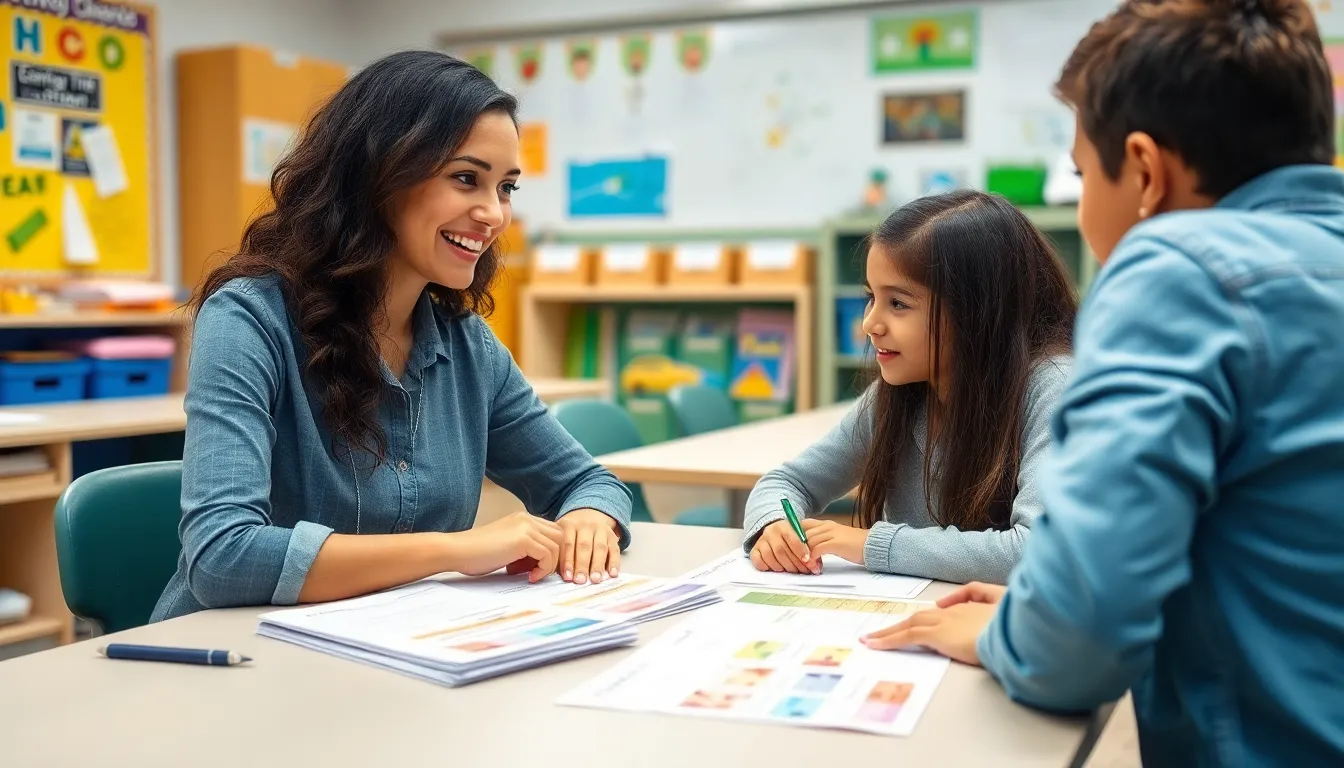Table of Contents
ToggleElementary report cards—those little pieces of paper that hold the power to make or break a parent’s day. They’re the ultimate report on a child’s academic journey, revealing everything from spelling prowess to math mastery. But let’s face it, they can be as nerve-wracking as waiting for a pop quiz.
Overview of Elementary Report Cards
Elementary report cards serve as essential tools for parents and teachers to gauge student performance. They provide insights into a child’s academic progress across various subjects, such as math, science, and reading. Each report card typically includes letter grades, proficiency levels, or descriptive feedback, allowing parents to understand how their child learns and where improvements may be necessary.
Feedback often highlights strengths in specific areas, encouraging continued development. Teachers use report cards to communicate not just grades but also behavioral aspects and participation in class activities. This comprehensive approach helps parents support their child’s learning journey effectively.
Included on report cards are assessments of skills, behaviors, and progress toward individual learning goals. For instance, a teacher may note that a student excels in group projects but struggles with independent work. Such detailed observations guide discussions at parent-teacher conferences.
Parents may feel anxious when reviewing report cards, a response that can mirror the stress of anticipating a pop quiz. Recognizing this emotion, educators work to foster a supportive environment that focuses on growth rather than punitive measures. Overall, a well-structured report card not only communicates academic standing but also serves as a roadmap for future learning.
Importance of Elementary Report Cards

Elementary report cards play a crucial role in a child’s academic journey. They provide essential feedback on performance and areas for growth.
Communication Between Teachers and Parents
Effective communication between teachers and parents hinges on report cards. Teachers use report cards to share insights about student progress in subjects, behavior, and participation. Parents gain a clearer picture of their child’s strengths and challenges through detailed comments and grades. Consistent updates foster collaboration, allowing families to support learning at home. By reviewing reports periodically, parents can engage in discussions about academic strategies and resources. Clarity in communication enhances relationships, ensuring that everyone involved remains focused on a child’s educational experience.
Assessment of Student Progress
Assessment of student progress occurs through various metrics on report cards. Letter grades indicate overall performance while proficiency levels provide detailed evaluations of specific skills. Descriptive feedback highlights achievements or areas needing improvement, offering guidance for future learning. Progress tracking aids in identifying trends over time, allowing for timely interventions if required. Understanding these assessments can motivate students by setting clear expectations and goals. Overall, report cards are integral for measuring success, ensuring that educators and families remain aligned in supporting students’ educational paths.
Types of Elementary Report Cards
Elementary report cards come in various formats, with each type providing unique insights into a child’s progress. Understanding these different formats helps parents and teachers support student learning effectively.
Standards-Based Report Cards
Standards-based report cards focus on specific learning goals set by educational standards. These report cards assess students’ proficiency in skills and knowledge based on these standards. Teachers use descriptors like “exceeds expectations,” “meets expectations,” or “needs improvement” to provide detailed feedback on student performance. Parents gain clarity on where their child excels and where additional support may be necessary. By tracking standards over time, it becomes easier to identify trends in a student’s academic growth.
Traditional Letter Grading
Traditional letter grading incorporates familiar letters such as A, B, C, D, and F to represent performance. This grading system simplifies communication about academic achievement, offering a straightforward representation of overall progress. Each letter correlates with a numerical score, allowing parents to understand how their child compares to classmates. However, traditional grading may not capture specific skill development or learning behaviors. Feedback often remains broad, which may leave some parents wanting more detailed insight into their child’s strengths and areas for growth.
Key Components of Elementary Report Cards
Elementary report cards contain essential information that reflects a child’s academic growth and development. These components offer insights for parents and teachers, promoting a clearer understanding of student achievement.
Academic Performance
Academic performance serves as a primary focus in report cards. Letter grades typically summarize student achievements in various subjects such as math, reading, and science. Teachers assess performance against established standards, using proficiency levels to indicate whether a student meets, approaches, or exceeds expectations. This assessment helps identify strengths and areas needing attention, guiding future learning paths. For example, a child may score an “A” in math while receiving a “C” in reading, prompting discussions on how to support reading improvement.
Social and Behavioral Skills
Social and behavioral skills underscore another key aspect of report cards. Teachers evaluate these skills through observations of student interactions in the classroom. Communication, teamwork, and respect for others are commonly assessed qualities. Comments alongside ratings provide richer context, helping parents understand how their child collaborates and engages with peers. For instance, a teacher might note that a child excels in group activities but struggles with following instructions. Such feedback highlights the importance of social development alongside academic knowledge.
Challenges with Elementary Report Cards
Elementary report cards face various challenges that affect their effectiveness in communicating student performance to parents and educators.
Standardization Issues
Standardization poses a significant challenge for elementary report cards. Diverse grading systems across schools create inconsistency in student evaluations. When teachers assess performance using different criteria, comparisons of student progress become complex. Schools may adopt varying approaches, making it hard to standardize expectations. Some use letter grades while others focus on proficiency descriptors. Without a uniform method for assessment, communicating achievement levels becomes problematic. Parents may struggle to interpret what a “meets expectations” designation means in one school compared to another. As a result, clarity in grading processes is essential to improve communication and understanding.
Parental Understanding
Parental understanding of report cards can often be insufficient. Many parents lack familiarity with the different grading systems in use. They may find it challenging to comprehend proficiency levels, especially when terms like “exceeds expectations” appear unfamiliar. Misinterpretation can lead to confusion about a child’s actual standing in their studies. Educators play a crucial role in ensuring that parents grasp the information presented. Providing detailed explanations of grading criteria can bridge this gap. Furthermore, holding informational sessions and offering resources can enhance parents’ ability to support their child’s learning. Effective communication between home and school enhances overall educational support.
Elementary report cards play a vital role in a child’s educational experience. They not only reflect academic progress but also encompass social and behavioral assessments. By providing a comprehensive view of a student’s strengths and areas for growth, these reports facilitate meaningful conversations between parents and teachers.
Effective communication is key to ensuring that families can support their child’s learning journey. As educators strive for clarity in grading systems, parents are encouraged to engage actively with report cards. This collaborative approach fosters a better understanding of a child’s development and promotes a supportive learning environment at home. Ultimately, elementary report cards serve as essential tools for guiding students toward success in their educational paths.






